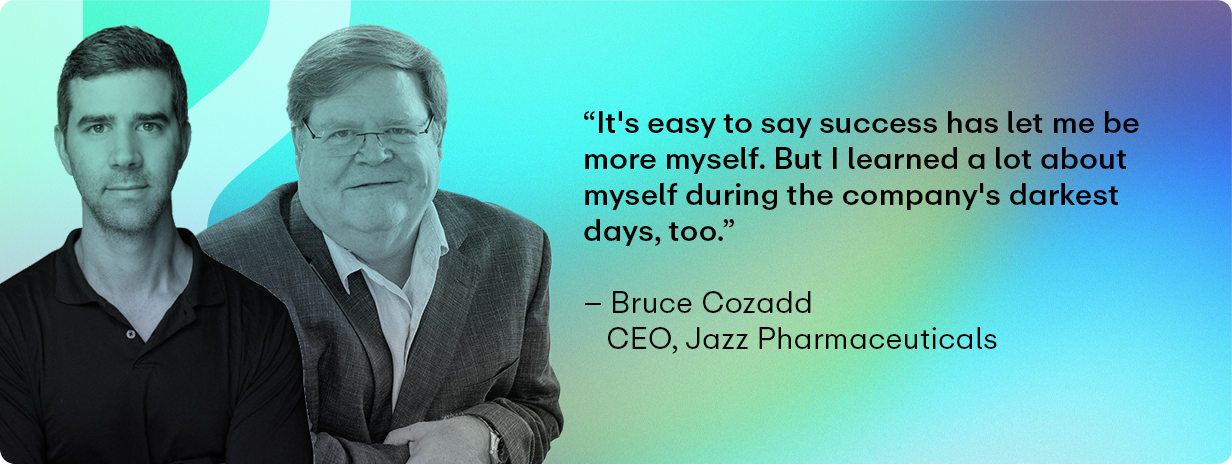Over the course of more than 20 years at Jazz Pharmaceuticals, Bruce Cozadd has forged one of the most unique cultures in life sciences. Influenced heavily by his love of the arts, Cozadd has led with passion, precision and empathy in equal measures.
As he nears the end of his exceptional run at Jazz – he announced late last year that he plans to retire as CEO once the company identifies a successor – Cozadd is eager to share what he has learned along the way. In this Q&A excerpt from his podcast interview with Kinara co-founder Chase Feiger, Cozadd looks back on Jazz’s evolution and passes on advice to the next generation of life-science leaders.
(This Q&A has been edited for length and clarity. To listen to the full Kinara podcast with Bruce Cozadd, click here.)
Feiger: How did the Jazz vision take shape as you started the company?
Cozadd: My inspiration as one of the founders of Jazz was to take what I learned at Alza about culture and how you treat people, and apply that culture to solving really important medical problems. The name Jazz played on a couple metaphors, one of which was this balancing of improvisation or innovation with structure. If you think about jazz musicians who have never played together before, they can get up on stage and play in front of an audience. Even though they’re improvising, they’re improvising on top of a structure they all understand.
We work in a highly regulated industry – regulated for good reason, I might add – but we still want to innovate in everything we do. Not just in R&D, but in how we approach patients, how we make treatments available, in anything we can do to make a difference in the lives of patients. So my focus is on people: patients as people and employees as people.
Feiger: How do you see art and science blending together as part of the company’s process?
Cozadd: It starts with applying creativity to solve a problem that’s worth solving. We start with the end in mind at Jazz; we don’t start by doing creative research and then follow it wherever it leads. We’re trying to solve a certain problem and we’re trying to think about that problem from a patient-centric point of view. Patients don’t always think in terms of regulatory endpoints. They think about how a particular disease is impacting their life, be it a chronic disease or an acute and life-threatening disease.
There was a tagline we used early in Jazz’s history: “Innovation That Performs.” Obviously “performs” is a little play on music, but it’s about innovation that matters, right? Innovation that performs for the patient does something the patient really cares about. If you’re intensely focused on the problem you’re trying to solve, you can work backwards to the best way to get where we want to go.
Feiger: Let’s talk more about the idea of improvisation within structure. How has this approach influenced some of Jazz’s therapeutic innovations?
Cozadd: Again, I would say innovation can happen anywhere in a company. I sometimes say, “Don’t innovate in accounting” – but other than that, innovation isn’t confined to one part of the organization.
I’ve often found we’ve had creative clinical regulatory strategies that have really made a difference for patients. One of my favorite examples of that is when we developed Rylaze, which we took from pre-clinical all the way through to market in record time. We were trying to solve a particular problem – making an enzyme available for patients that had been in short supply before – and we collaborated with FDA and the Children’s Oncology Group to think about how we could do that in the quickest way possible.
For example, we had a pre-IND meeting without a molecule. You don’t usually go to regulators and say, “Let’s talk about our development program even though I don’t have a molecule yet.” But we had an idea of what we wanted to try to accomplish. We ultimately took two parallel programs forward, assuming we’d choose the best one when we hit a certain point in development, and we had a very open and collaborative relationship with FDA. We said, “If we see each other doing anything that could be done faster, let’s call each other on it. Let’s try to move this forward.”
Feiger: Another area where Jazz has brought art into the process is through its patient-centered model. Where did this idea come from? And how does this approach differ from what we typically see in pharma?
Cozadd: First of all, I don’t want to presume that we don’t see it in pharma. I don’t know what’s going on inside every organization, but I know what’s going inside our organization. When we have those moments that I think happen in many companies – where we are exposed to a patient story, with a patient standing on stage or a patient filmed in a video or however it’s conveyed – it’s often very impactful. What I like to do is make sure we don’t lose sight of that person, so we check in with them again a year later, five years later, 10 years later. What’s going on in their life? How did that moment of therapy really impact them? And again, this isn’t about clinical endpoints. It’s about, “I was able to go back to grad school. I was able to pursue a dream I had. Here’s how it impacted my family around me. Here’s the good I was able to do with my career based on the successful treatment I received.”
We brought forward a lower sodium version of a chronic medication in part because we were watching patients on medication for five years, 10 years, 15 years and more and recognizing the cardiovascular burden that high sodium load conveyed in this particular disease state. It caused us to go back and engineer a different product to meet that need. So again, we’re not just thinking about one moment of intervention, but really how we can impact someone’s life through what we do as a company.
Feiger: You’re one of the most empathetic leaders I’ve had the opportunity to meet. How do you cultivate that compassion in the next generation of leaders at Jazz?
Cozadd: If you grew up in the arts – I was in both choruses and a capella singing groups – you’re aware of the impact of emotion in the arts. I’m very moved by patient stories and I’m also very moved by live musical and theatrical performances. I go to as many as I can. So storytelling can be an effective way of conveying information in a way that people are more likely to remember. It’s more likely to effect change if you can connect in that way.
You asked specifically how you pass this along to employees or other leaders. I believe that part of inculcating and reinforcing a strong culture is what you choose to reward inside an organization. So we think about what behaviors we want and what behaviors we reward. We talk a lot about collaboration and we don’t define collaboration as just inside the company. How do you collaborate with regulators? Advocacy organizations?
Once you establish those values, reward them. If you think hard about what you reward, you’ll see more of it. I’ll give you one example: It’s always tempting to reward the project team that comes in and works over a holiday or works late into the night to make things happen at the last minute, and sometimes that is absolutely worthy of recognition. But what about the other team next door that planned everything perfectly, executed well and didn’t need to come in that last weekend? What are you saying to them if you reward the first team? So we think about what we’re signaling to the organization when we reward certain behaviors. We’re very intentional about that.
Feiger: There are a lot of future leaders who want to build with a similar philosophy and combination of creativity, empathy and scientific rigor. What’s one piece of advice you’d offer to them?
Cozadd: It’s hard to limit it to just one piece of advice, so I’ll share a couple. One is to learn from leaders you admire. In my case, the person who’s had the biggest impact on my career was Alejandro Zaffaroni, who founded Alza. I was profoundly impacted by the way he ran an organization and I try to model myself in many ways after him.
And the other thing I recommend is to be your authentic self. I try to be the same person whether I’m with new employees, a management team, a board of directors, investors, advocacy groups, competitors or collaborators. I would say to leaders that they should try to figure out as early as possible what they stand for and what’s important to them, and then stick by that.
It’s easy to say success has let me be more myself. But I learned a lot about myself during some of the company’s darkest days, too. It’s both successes and challenges that make you more comfortable with who you really are and what’s really important.
Feiger: Looking ahead, what excites you the most?
Cozadd: I don’t want to claim that Jazz has a role in changing the whole world. But when we choose a particular set of patients or a particular disease to focus on, I think we can make a real difference – and part of that is trying new approaches to solve problems. This is where the jazz analogy comes back to me. If you think about jazz as a genre or jazz musicians individually, they’re always moving forward. They’re always trying something new. It’s never, “I’m done now, I’ve solved the problem, I’m going to do it the same way forever.”
I’m 21-and-a-half years into the journey with Jazz. Patients and investors and employees never say, “Oh, we’re done, we’ve achieved this.” It’s always about continuing to push forward. That’s inspiring to me.




